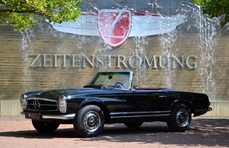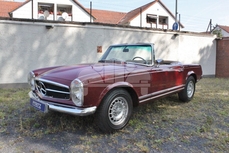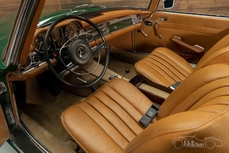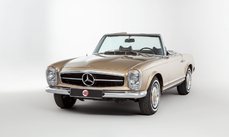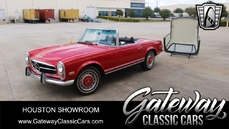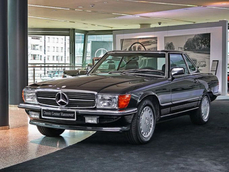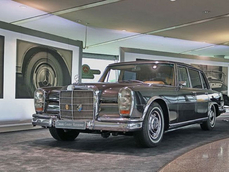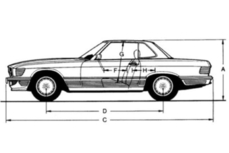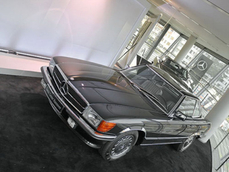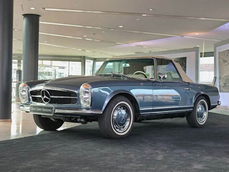Mercedes-Benz 280SL w113 280 SL (1970) ZUM RESTAURIEREN 1970
General description :
Preis:
EUR 87.500,– (§25a UStG differenzbesteuert)
Fahrzeughistorie:
Auf dem Autosalon in Genf 1963 lüftete die Daimler-Benz AG ein streng gehütetes Geheimnis: Erstmalig war der neue SL zu sehen, der die Nachfolge des 190SL und auch des legendären 300SL antreten sollte. Ein schweres Erbe? Nicht wirklich. Seine Konstrukteure hatten ihre Hausaufgaben gründlich gemacht und den Novizen bestens ausgestattet. Die moderne gradlinig geschnittene Karosserie und der luxuriöse lichtdurchflutete Innenraum trafen genau den Zeitgeschmack. Weit nach vorn ausgeschnittene Türen ermöglichten einen für Sportwagen ungewöhnlich bequemen Einstieg und die großzügige Verglasung sorgte für einen hervorragenden Rundum-Blick. Auch technisch verstand der "Neue" zu brillieren: Ein kräftiger 6-Zylinder-Einspritz-Motor verhalf zu überdurchschnittlichen Fahrleistungen, dem serienmäßigen 4-Gang Schaltgetriebe konnte man auf Wunsch einen 5. Gang spendieren, oder - erstmalig in einem SL - ein modernes Automatikgetriebe ordern. Ausserdem war auch eine Servolenkung lieferbar, was den Komfortanspruch der 60er Jahre deutlich übertraf. Kein Wunder, daß sich sofort ein großer Verkaufserfolg einstellte, die Modellnachfolge war perfekt geregelt.
Das optional lieferbare Hardtop sollte auch für die Zusatzbezeichnung dieses Modells Pate stehen : Das ungewöhnlich nach innen gewölbte Mittelteil des Dachs verlieh dem SL nicht nur ein sportlich-dynamisches Erscheinungsbild, sondern erinnerte auch an japanische Pagoden mit ihrer typischen Dachkonstruktion. Der Name "Pagode" war fortan untrennbar mit diesem SL verbunden.
Produziert wurde die "Pagode" von 1963 - 1971. Zunächst als 230SL, 1967 folgte der 250SL und ab 1968 bis Produktionsende wurde der 280SL gebaut. Insgesamt wurden knapp 49.000 Fahrzeuge hergestellt, mehr als die Hälfte wurden exportiert.
In der langen Tradition der Fahrzeuge mit der Bezeichnung "SL" hat sich die "Pagode" in der Szene fest etabliert. Die Formgebung, die beherrschbare Technik, eine beruhigende Ersatzteilversorgung und besonders die problemlose Handhabung im alltäglichen Gebrauch ließ die Fan-Gemeinde im Laufe der Zeit immer größer werden.
Dieses Fahrzeug:
Eine deutsche "Pagode" aus dem vorletzten Produktionsjahr 1970. Das Auto ist bereits vor längerer Zeit einmal revidiert worden und in "DB 904 dunkelblau" umlackiert worden, was dieses Auto in Verbindung mit der schwarzen Innenausstattung und den Leichtmetallfelgen sehr maskulin wirken lässt. Die Jahre im Gebrauch haben Spuren hinterlassen, dennoch ist der optische Allgemeinzustand recht ordentlich - hier ist es Ermessens-Sache, was man verändern möchte, oder was man einfach so lässt wie es ist. Der SL ist uneingeschränkt fahrbereit, aber es bedarf in nächster Zeit an Zuwendung für den Motor, die Achsen und einigen Aggregaten - der technische Allgemeinzustand kann mit befriedigend bis ausreichend beschrieben werden. Wir bieten dieses Auto daher als Restaurier-Objekt an, was dem zukünftigen Besitzer alle Möglichkeiten offen lässt...
Sonderausstattung & Zubehör:
Automatikgetriebe
Lederpolster
Leichtmetallräder
Radio
Außenspiegel rechts
1970 Mercedes-Benz 280SL w113 280 SL (1970) ZUM RESTAURIEREN is listed for sale on ClassicDigest in Podbielskistraße 293DE-30655 Hannover by Daimler AG, vertreten durch die Mercedes-Benz PKW GmbH, Ndl. Hannover | Classic Center Hannover for €78850.
Car Facts
Car type : Car Make : Mercedes-Benz Model : 280SL w113 Model Version : 280 SL (1970) ZUM RESTAURIEREN Engine size : 2.8 Model Year : 1970 Sub type : Convertible Location : Podbielskistraße 293DE-30655 Hannover Vehicle Registration : Undefined
78850 €
Seller Information
Daimler AG vertreten durch die Mercedes Benz PKW GmbH, Ndl. Hannover | Classic Center Hannover
Daimler AG, vertreten durch die Mercedes-Benz PKW GmbH, Ndl. Hannover | Classic Center Hannover
+49 (0)511 51544515
Daimler AG, vertreten durch die Mercedes-Benz PKW GmbH, Ndl. Hannover | Classic Center Hannover
+49 (0)511 51544515
People who viewed this Mercedes-Benz 280SL w113 also viewed similar Mercedes-Benz listed at ClassicDigest
Other cars listed for sale by this dealer
About Mercedes-Benz
In the annals of automotive history, the journey of Mercedes-Benz is a tale that unfolds with the ingenuity of its founding pioneers. In the year 1886, Karl Benz crafted the Benz Patent Motorwagen, a creation that would go down in history as the world's inaugural automobile. Unbeknownst to him, this moment marked the genesis of what would evolve into the most illustrious premium car manufacturer globally. The financial underpinning of this pioneering venture, interestingly, was provided by Karl Benz's wife, Bertha Benz, demonstrating a remarkable partnership that would set the tone for Mercedes-Benz's legacy.A parallel narrative emerged not far away, as Daimler-Motoren-Gesellschaft, founded by Gottlieb Daimler and Wilhelm Maybach, entered the scene. In 1901, they unveiled their automobile under the now-famous moniker "Mercedes," meaning "godsend" in Spanish. This name was bestowed upon the car at the behest of Emil Jellinek's daughter, the distributor for Daimler-Motoren-Gesellschaft. The wheels of innovation were set in motion.
Fast forward to 1926, a pivotal year that witnessed the merger of Daimler with Benz & Cie., culminating in the birth of Daimler-Benz. The amalgamation saw the adoption of "Mercedes-Benz" as the distinguished trademark for their automobiles, fusing the legacies of two visionary entities into one.
Contrary to perceptions of conservatism, the trajectory of Daimler-Benz unfolds as a chronicle of industry firsts. From the introduction of the honeycomb radiator to the float carburetor, and the pioneering implementation of four-wheel brakes in 1924, Daimler-Benz consistently pushed the boundaries of automotive innovation. The diesel-powered Mercedes-Benz 260 D in 1936 marked the inception of diesel engines in passenger cars. The iconic Mercedes-Benz 300SL Gullwing made history as the first car with direct fuel injection, albeit the Gutbrod's tiny 2-stroke engine can claim precedence.
Safety innovations became a hallmark, with Béla Barényi's patented safety cell design in the "Ponton"-models in 1951, featuring front and rear crumple zones. The W116 450SEL 6.9 saw the introduction of the Anti-Lock Brake system (ABS), another pioneering safety feature. From the first production airbags and beyond, the legacy of "firsts" continued to be etched into the fabric of Daimler-Benz.
Over its centennial journey, Mercedes-Benz has not merely produced cars but has sculpted automotive icons. The SSKL, 710 SSK Trossi Roadster, 770K Grosser, 540K Spezial Roadster, 300SL Gullwing, w100 600 Pullman, w111 280SE 3.5 Flachkühler, w113 230SL Pagoda, w109 300 SEL 6.3, and w201 2.3-16 Cosworth stand testament to the brand's commitment to engineering excellence.
The roaring Silver Arrows, or "Silberpfeile," including the W 25, W 125, W154, W165, and W196, created a legacy of dominance on the racetrack. These machines were not merely cars; they were expressions of precision, speed, and an indomitable spirit that left their competitors in the dust.
As Mercedes-Benz marches into the future, it does so not just as an automaker but as a custodian of a legacy, a torchbearer of innovation, and a beacon of automotive excellence. The road ahead is sure to witness the continued fusion of cutting-edge technology, timeless design, and an unwavering commitment to setting new standards in the world of automobiles.
One luminary figure who left an indelible mark was Béla Barényi, often heralded as the "father of passive safety" for his pioneering work in safety engineering. His patented safety cell design, featuring front and rear crumple zones, became a hallmark of Mercedes-Benz's commitment to occupant safety, setting new standards that reverberated throughout the automotive world.
Moving through the chronicles, the collaborative genius of Wilhelm Maybach, alongside Gottlieb Daimler, laid the foundation for Daimler-Motoren-Gesellschaft. Their innovations not only birthed the first Mercedes but established a culture of relentless pursuit of technological excellence that remains integral to Mercedes-Benz's DNA.
In the post-merger era of 1926, Ferdinand Porsche emerged as a prominent figure within Mercedes-Benz. His work on the Mercedes-Benz S-Type, a supercharged race car, garnered acclaim and set the stage for a legacy that extended far beyond the marque. Porsche's impact would later extend to his eponymous company, but his influence at Mercedes-Benz during those formative years was pivotal.
As the 20th century progressed, the legendary Rudolf Uhlenhaut emerged as a key figure. Uhlenhaut, an accomplished engineer and the driving force behind the iconic Silver Arrows, played a crucial role in Mercedes-Benz's dominance in motorsports. His engineering prowess and attention to detail were instrumental in creating some of the most formidable racing cars of the era.
In the latter half of the century, figures like Bruno Sacco, the head of design at Mercedes-Benz from 1975 to 1999, left an indelible imprint on the brand's aesthetic identity. Sacco's design philosophy, characterized by clean lines and timeless elegance, shaped iconic models like the W126 S-Class and the W201 190E, solidifying Mercedes-Benz's reputation for luxury and sophistication.
The narrative would be incomplete without acknowledging the contributions of engineers like Hans Scherenberg, whose leadership in the 1970s ushered in a new era of technological innovation at Mercedes-Benz. Scherenberg's tenure saw the development of groundbreaking technologies, including the Anti-Lock Brake system (ABS) and the introduction of airbags in production cars.
















